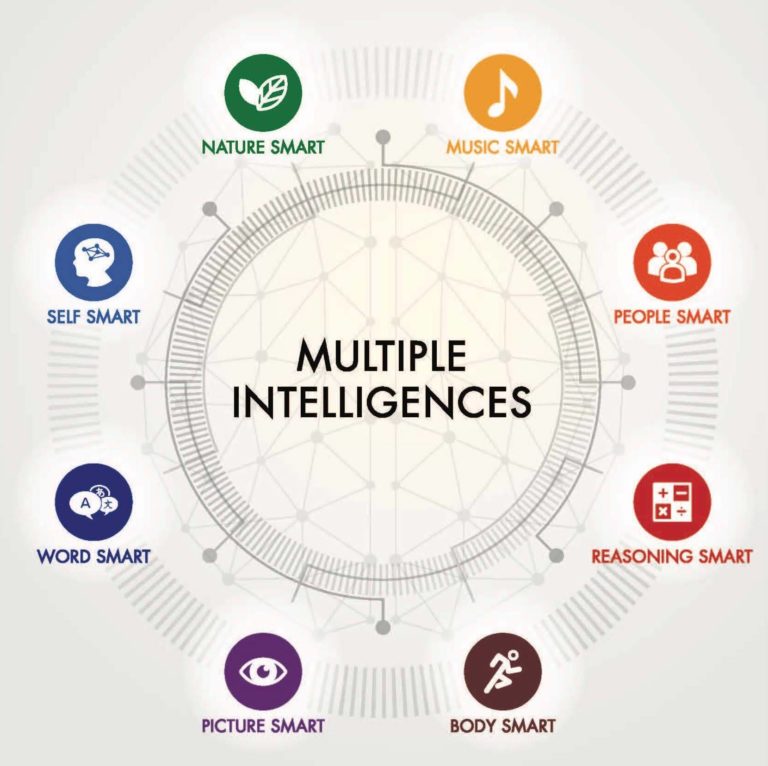Maybe you’ve heard about the theory of multiple intelligences, but you’re not sure how it works in your classroom. Maybe you’ve never heard of it, but you know some of your students are smart in ways tests aren’t measuring. Or maybe you’re just looking for a spark to liven up learning this year. No matter what, multiple intelligences can give you – and your students – a new way to approach learning.
The Theory of Multiple Intelligences
In 1983, Howard Gardner proposed the theory of multiple intelligences (MI), though he has continued to revise his theory over the years. He felt the traditional concept of intelligence was incomplete and instead proposed a variety of different types of intelligence, such as:
- Linguistic (skilled with words and language)
- Logical-mathematical (skilled with logic, reasoning, and/or numbers)
- Bodily-kinesthetic (skilled at controlling bodily motion such as sports, dance, etc.)
- Visual-spatial (skilled with images, spatial judgment, and/or puzzles)
- Musical (skilled with sound, rhythm, tone, and music)
- Interpersonal (skilled at communicating with/relating to others)
- Intrapersonal (skilled at self-knowledge, reflection, etc.)
- Naturalistic (skilled at understanding/relating to the natural world)
For many teachers, MI theory makes perfect sense. Who hasn’t had a student who couldn’t write a coherent paragraph but can solve any kind of puzzle you put in front of them? Or the student who persists in tapping their pencil rhythmically as they study because “it helps them think”? While not all questions about the science of MI have been answered, it can be extremely helpful in the classroom.
How to Use Multiple Intelligences in the Classroom
Get to Know Your Students Better
There are many MI assessment tools available online and to print for use in your classroom. These tests can provide a fascinating snapshot of your students’ innate abilities. Students should think about how to use their strengths to help them in all subjects. Maybe that musically intelligent student should make up a song to help her learn the Periodic Table of Elements. Or that visually inclined student should draw a picture to help remember the life cycle of a butterfly.
Expand Upon Traditional Activities
Traditional school activities focus primarily on linguistic and logical-mathematical intelligences. But here are some ways to reach any intelligence type in your classroom:
Linguistic
Ask students to write a story about what they’re studying. If they’re learning a process, have them write an instruction manual or give a “how to” speech. Writing scripts, making videos, or designing a brochure are other good activities for this intelligence.
Logical-Mathematical
Beyond doing math problems, this intelligence focuses on logical reasoning and problem solving. Can students conduct a survey and graph or chart the results? For English or history classes, use a debate to teach the basics of logic and rhetoric. Ask students to function the way a real-life scientist does – using logic and/or math to solve a problem or propose a hypothesis.
Bodily-Kinesthetic
Let bodily-kinesthetic students act out a skit, do a dance, or physically simulate a scientific process. Use manipulatives in math, have them build a model with clay, or create a collage about an important concept.
Visual-Spatial
Let these “picture-smart” students draw a diagram, illustrate a group project, or develop a PowerPoint presentation. You may want to encourage this group to use symbols or colors to help them make sense of their notes, since they may struggle with traditional note-taking methods. Graphic organizers can also help them.
Musical
These students may be gifted musicians, but they also tend to have a good ear for rhythms and a sense of patterns. Consider musical activities such as having them create a rap song about their subject or make connections between sound/music and the information you are teaching. For example, ask students to choose three pieces of music – one that represents a solid, one that represents a liquid, and one that represents a gas. Have them play a clip of each piece of music and then explain why they chose each one – this will appeal to their interests while still allowing you to check for comprehension (e.g., the “solid” music should sound heavier than the “gas” music). These students may also enjoy creating podcasts or other auditory items.
Interpersonal
These learners are usually the ones who speak up frequently. Take advantage of that chatty energy through class discussions or group work, let them teach the class, or use technology to have them interact with others via Skype, chat, etc.
Intrapersonal
Give these students assignments that challenge them to make connections between their personal experiences and the class subject. Blogs, journals, and essays on personal topics are common tasks, but these students can also benefit from metacognitive assignments, that is, encouraging them to think about their own learning styles and processes. Developing a portfolio of individual assignments may also appeal to these students.
Naturalistic
Incorporate the outside world to hold these students’ attention. Field trips and project-based learning are ideal, but anything that allows them to get some fresh air and interact with plants and animals will help. Take class outside on a nice day, or invite these students to help you take care of a classroom garden. Use natural items like flowers or rocks for math manipulatives or have them write a poem about the sky.
Coming up with assignments to reach all of the multiple intelligences can be very time-consuming, so start small! Pick one or two intelligences that you don’t normally use in your lessons, and find a way to incorporate them. Interpersonal, intrapersonal, and naturalistic can be some of the easier ones to start with.
Another solution? Choose one common assignment (for example, book reports) and brainstorm MI alternatives, such as: write a song about the book, build a diorama about the book, etc. Then allow students to choose an alternative to the traditional assignment once in awhile. You might be surprised by the results!




